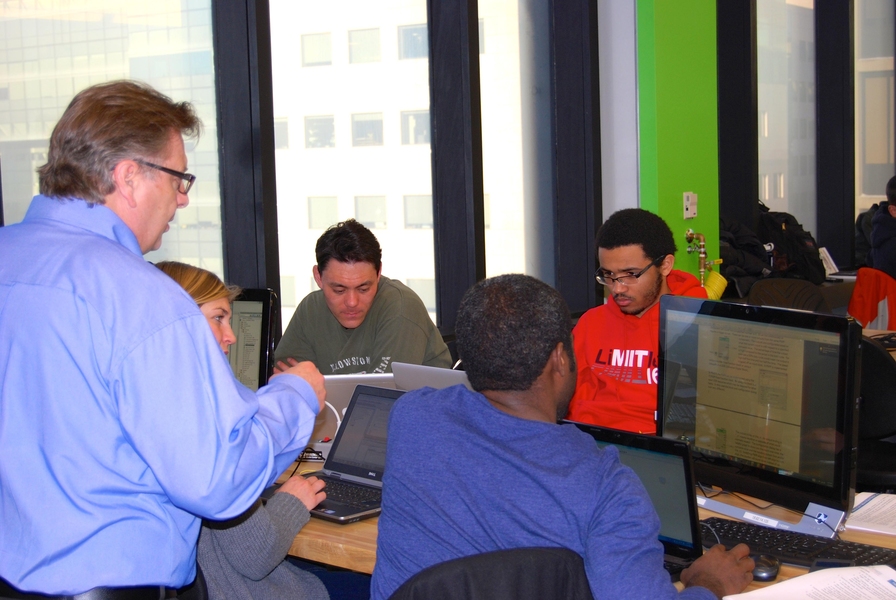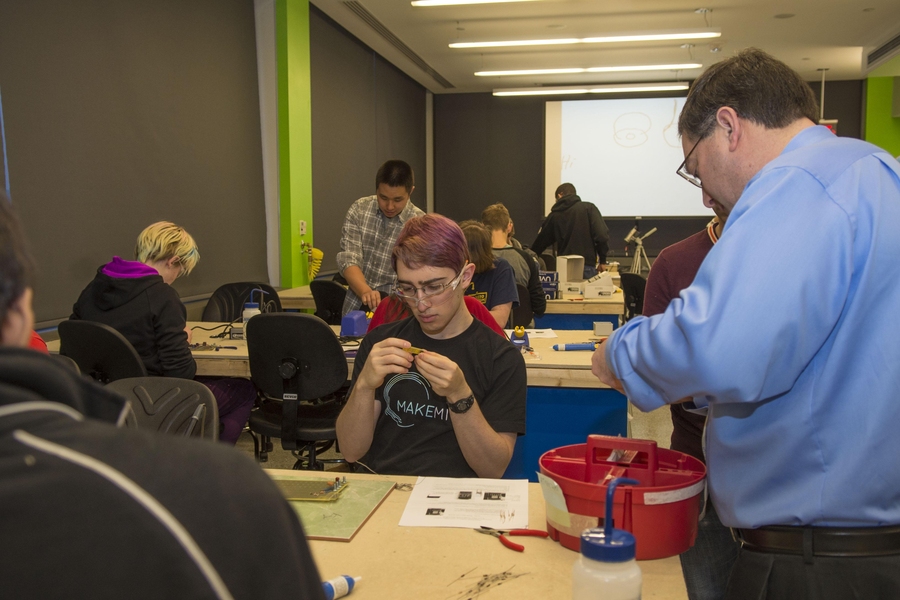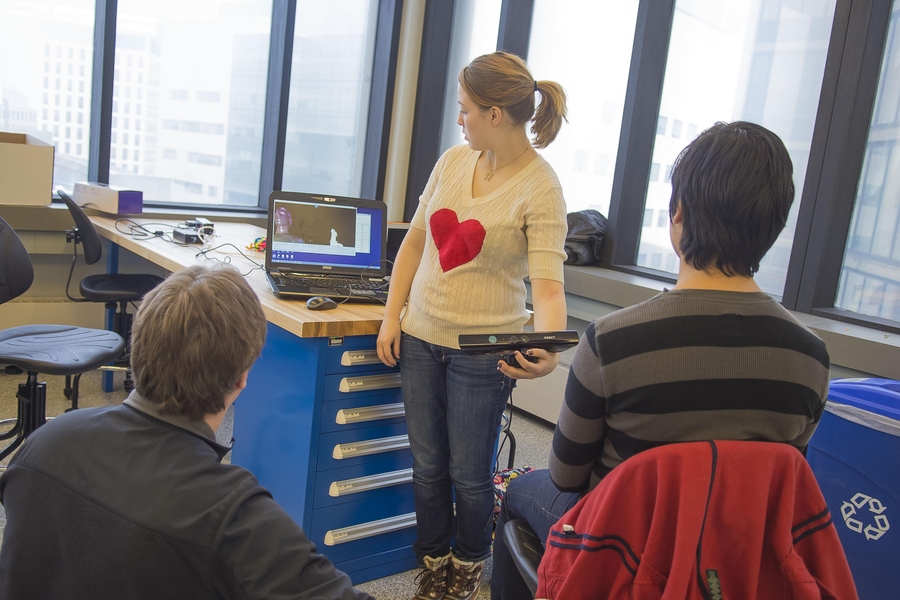Electrical engineering and computer science students at MIT are accustomed to designing the circuitry or control algorithms for, say, a robot. But they have largely been left out of building the robot itself. Now, a teaching laboratory called the Engineering Design Studio (EDS) enables them to fabricate entire electronics-based systems.
“I had never soldered before I came [to MIT], and I had never used a drill,” says Lizi George ’12 MEng ’14, who works as a teaching assistant in the new fabrication facility. “The majority of EECS students don’t have that experience. But that’s one of the goals of MIT — the ‘mind and hand’ motto, getting the hands-on experience.”
George had a revelation when, as an undergraduate, she took machining and power electronics classes with Steven Leeb ’87, SM ’89, PhD ’93, an EECS professor and member of the Research Laboratory of Electronics. “I was totally struck — I had never built anything before,” she says.
Leeb allowed undergraduates to use his own laboratory space, but the equipment wasn’t up to date, and ongoing research projects took precedence over class assignments. He decided that MIT needed an advanced prototyping facility dedicated to EECS. “If you think about MIT after World War II or during the sixties and seventies, that’s when the students who were coming to us fixed cars or were ham radio operators,” Leeb says.
“The nature of how to connect engineering science with practical applications has changed. [With EDS], we want to convey some of the excitement of modern manufacturing.” With laser cutting tools, a soldering station, and other fabrication equipment, Leeb says, “students can easily create all the mechanical assembly required for an iPod dock and two speakers. They learn firsthand how two resistors are going to lower a voltage. It’s not just an abstract problem.”
The EDS has been in use since January, during the Independent Activities Period, but will formally open April 1.
Brian Sennett ’13, an EECS graduate student and teaching assistant in EDS, says he knew in high school that he wanted to be an engineer. “When I came to MIT, I was undecided between EECS and mechanical engineering,” he says. “I liked computers, so I gravitated to computer science, but I realized I’d rather do more hands-on building.” EDS enables students like him to experience “how electrical things work with mechanical things,” he says. For his thesis, he is building a sensor system to detect how many people are in a room based on their electrical properties.
The students in EDS are making use of a game-changing technology called PSoC, or programmable system on a chip. Provided by Cypress Semiconductor, which sponsored the creation of EDS in Building 38, the chips can both receive analog input — from human touch or a temperature sensor, for example — and process that input digitally for the desired application. Previously, these different capabilities required separate components, such as amplifiers, an analog-digital converter, and a computer.
PSoC, Leeb says, “is like having a whole parts store on a chip. You can program it to be what you want.” Currently, these chips are in everything from smartphones to automobile control consoles to computer-network servers.
Cypress CEO T. J. Rodgers, who created the Cypress University Alliance in 2006 as a way to engage with engineering students and educators, says that his company’s alignment with MIT is strong.
“MIT students grasp what our design tools do for them, and we’re trying to enable them to be the great engineers that we know they’re going to be,” Rodgers says. “We believe in getting the best minds and enabling them to develop the really cool things of the future. It’s a fun and exciting process.”
Patrick Kane, director of the Cypress University Alliance, works directly with MIT faculty and students. Providing educational tools is key, he says. “Students should learn as many technologies as they can when they’re in school.”
Agilent Technologies Electronic Measurement Group (soon to be Keysight Technologies), a manufacturer of testing and measurement instruments, has partnered with the Cypress University Alliance in supporting EDS. It donated state-of-the-art mixed-signal oscilloscopes, which allow the precise observation and generation of electrical signals.
“Agilent is excited to support the EECS department at MIT,” says Jay Alexander, vice president and general manager of the company’s Oscilloscope and Protocol Division. “It’s an excellent opportunity to give back and to help enable the education of future engineers at such a prestigious research and teaching institution.”
Anantha Chandrakasan, EECS department head and Joseph F. and Nancy P. Keithley Professor of Electrical Engineering, acknowledges Cypress’s and Agilent’s support. “Their involvement in EDS provides students with not only the most sophisticated equipment, but also the know-how to design and build their own systems. We are thrilled at their technical engagement with MIT.”
Students build their own electronics with help from Cypress Semiconductor
Publication Date:

Caption:
Cypress engineers Mike Daly and Rob Dick introduced students from across the School of Engineering to the Cypress PSoC 4 in October 2013.
Credits:
<br />Photo: Steve Leeb

Caption:
Freshmen, including Winter Guerra (pictured here), built loud-speakers and stereo-amplifiers of their own design in the new Cypress Engineering Design Studio to explore resonant systems and power conversion.
Credits:
<br />Photo: Steve Leeb

Caption:
Cypress engineer Patrick Kane (left) introduced MIT students from across the campus to the new Programmable System on Chip (PSoC) in January 2014.
Credits:
<br />Photo: Steve Leeb

Caption:
Professor Steve Leeb (right) guides students in 6.115 lab in the new EDS lab space.
Credits:
<br />Patricia Sampson

Caption:
Professor Wojciech Matusik (left) works with students to develop 3-D printed objects in 6.S079 Computational Fabrication.
Credits:
<br />Patricia Sampson





